.png)
If you’ve ever walked through a high-rise and noticed those mysterious red pipes or cabinets marked “Dry Riser” or “Wet Riser”, you might have wondered, “What on earth are those for?” Spoiler: they’re not decoration; they’re actually lifelines in a fire emergency.
Riser systems are vertical pipes built into tall buildings that let firefighters get water to upper floors quickly. Instead of dragging heavy hoses up stairwells, crews connect directly to these risers and instantly have water (or, in some cases, can fill the pipe with water on demand).
Here’s where it gets interesting: there are two main types of risers – wet and dry. Wet risers are always full of water, ready to go at a moment’s notice. Dry risers, on the other hand, stay empty until firefighters charge them with water. Both have their place, depending on a building’s size and design.
In this guide, we’ll break down what wet and dry risers are, how they differ, where they’re used, and why they’re such a critical piece of fire safety.
At its simplest, a riser is just a vertical pipe that runs up through a building, giving firefighters a shortcut to deliver water to higher floors. Instead of hauling long, heavy hoses up stairwells (which is exhausting and time-consuming), crews can connect to the riser and get water where it’s needed in minutes.
Think of it like an express elevator for water. The fire service hooks up their pump at street level, and suddenly every floor with a landing valve has water ready for firefighting.
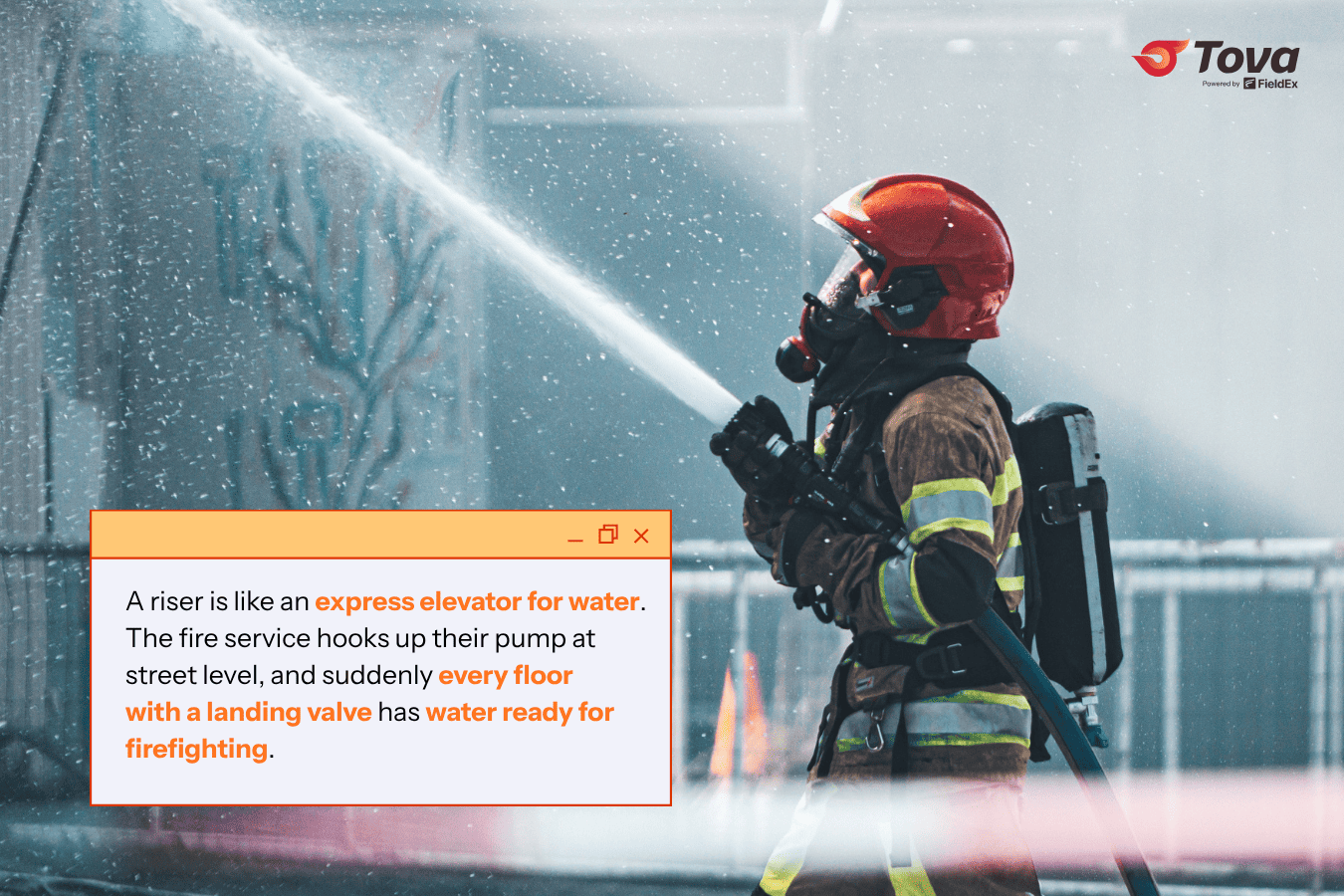
Building codes usually kick in once a building gets tall enough that carrying hoses isn’t practical:
In short: A riser is a built-in lifeline that ensures firefighters don’t lose time – or pressure – when fighting a blaze on upper floors.
A wet riser is exactly what it sounds like: a vertical pipe that’s always kept “wet”, meaning it’s permanently charged with water. Think of it as a fire hose that’s already primed and ready to go 24/7.
Picture a fire breaking out on the 18th floor of a high-rise hospital. With a wet riser, firefighters don’t have to spend time hooking up hoses at ground level. They simply connect to the landing valve outside the ward, open it up, and water is there – fast.
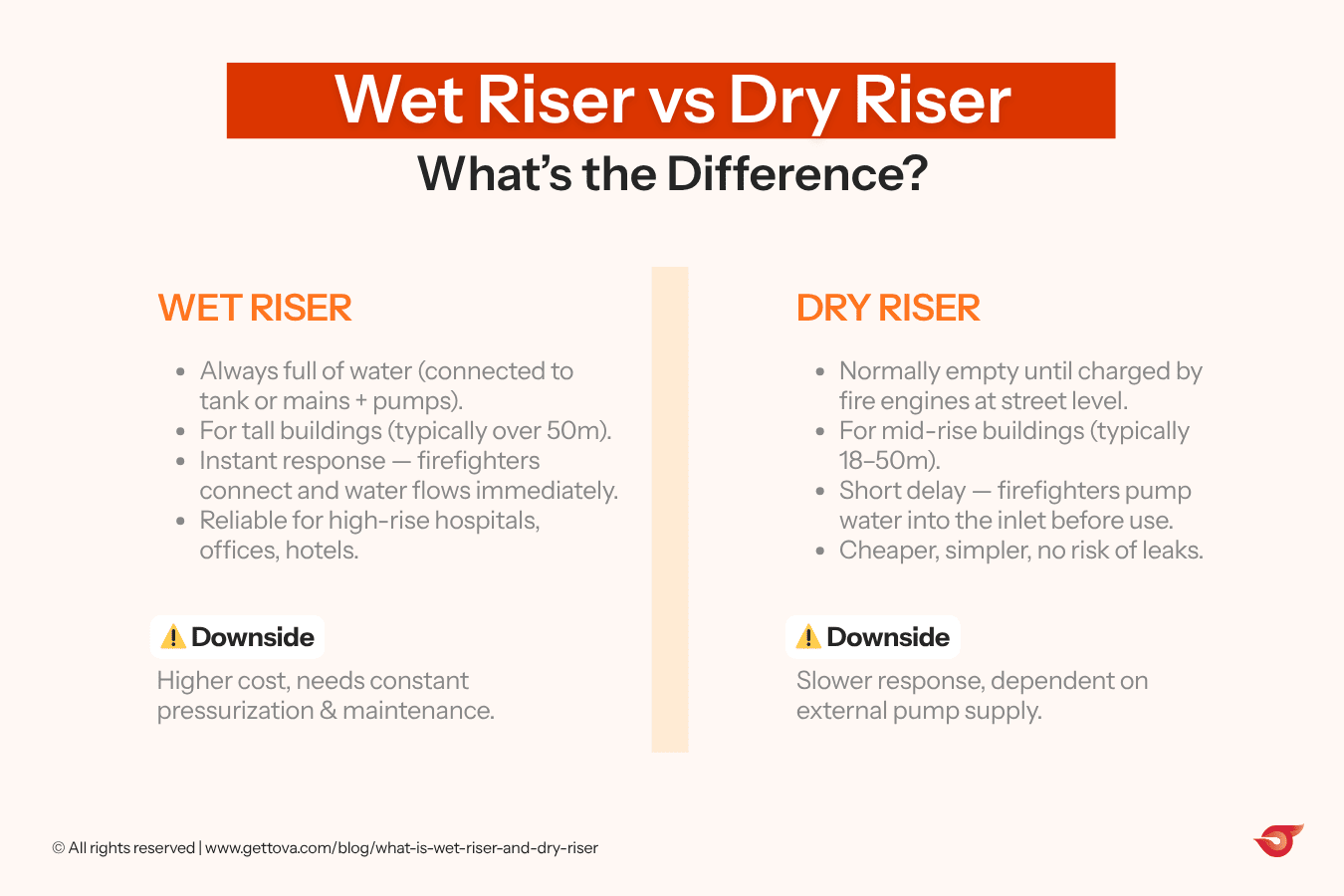
If a wet riser is always “ready with water”, then a dry riser is the opposite – it’s an empty vertical pipe that stays dry until it’s needed.
Instead of being constantly filled with water, the dry riser only gets charged when firefighters connect a pump at ground level. In other words, it’s like a hollow fire hose that only comes to life during an emergency.
Imagine a fire starting on the 7th floor of a car park. Firefighters arrive, hook their pump to the dry riser inlet at street level, and within minutes, the system is pressurized. Crews on the 7th floor connect their hoses to the landing valve and tackle the blaze – without dragging 7 stories of hose.
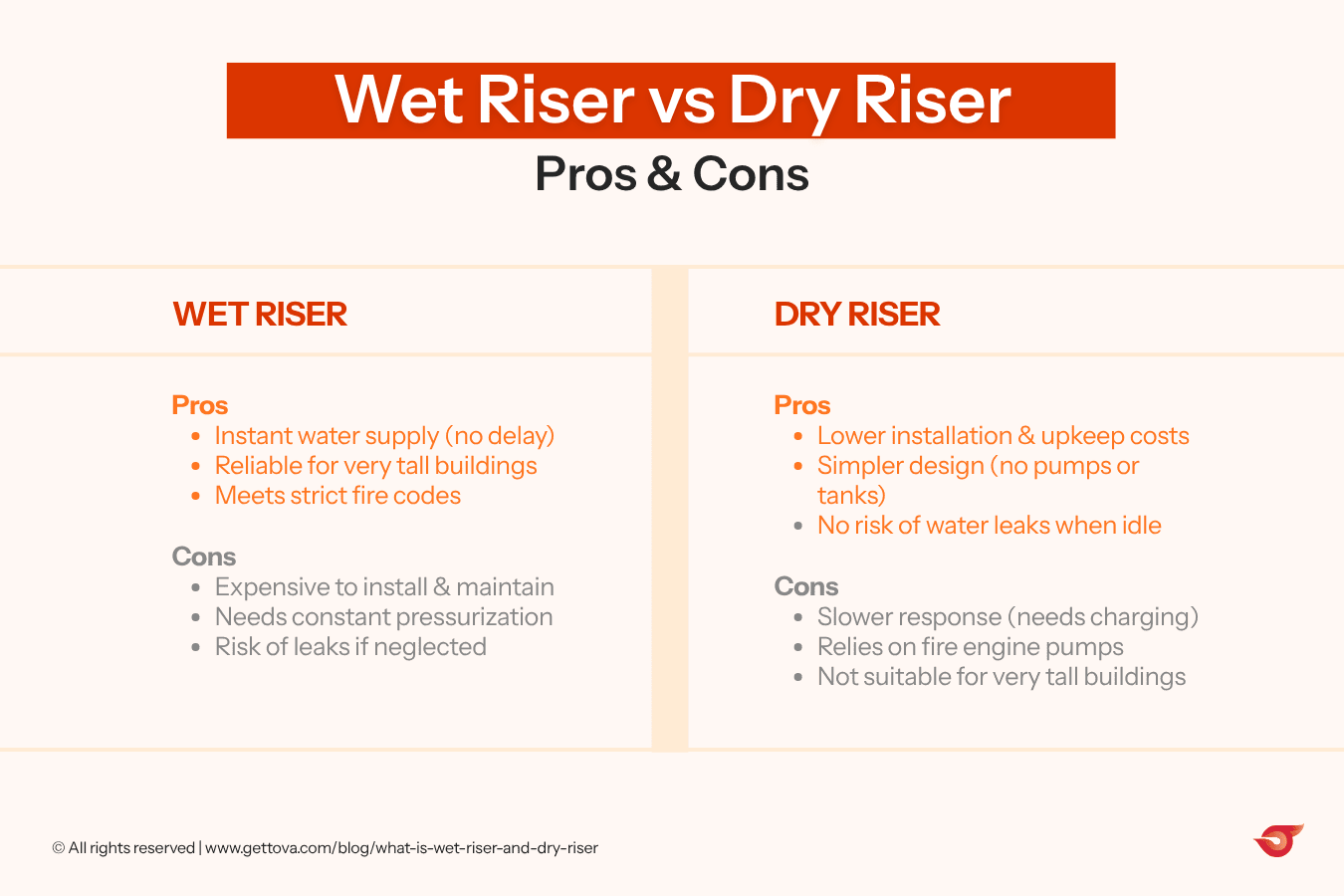
At a glance: wet risers are permanently filled with water for instant firefighting on upper floors, while dry risers stay empty and are charged by the fire service when needed. Use wet in very tall buildings where speed matters most; use dry in medium-rise buildings where constant pressurization isn’t required.
Risers aren’t optional extras; they’re required by law in most countries once a building reaches a certain height. The idea is simple: if firefighters can’t easily haul hoses up to where the fire is, the building itself has to help out by providing that vertical pipeline.
It’s not arbitrary. The cutoff points are based on physics:
In short: Riser systems are legally required once a building reaches heights where manual firefighting becomes impractical. Codes differ slightly around the world, but the goal is universal: keep water where it’s needed, as fast as possible.
Riser systems may not be flashy, but in high-rise firefighting, they’re absolute game changers. Without them, battling a fire on the 10th, 20th or 30th floor would be painfully slow, and dangerously risky. Here’s why they matter so much:
In a fire, seconds matter. Imagine firefighters dragging hundreds of feet of hose up stairwells before even starting to fight the flames. A riser eliminates that delay. With a wet riser, water is available immediately. With a dry riser, it only takes a quick hookup at street level to get water flowing.
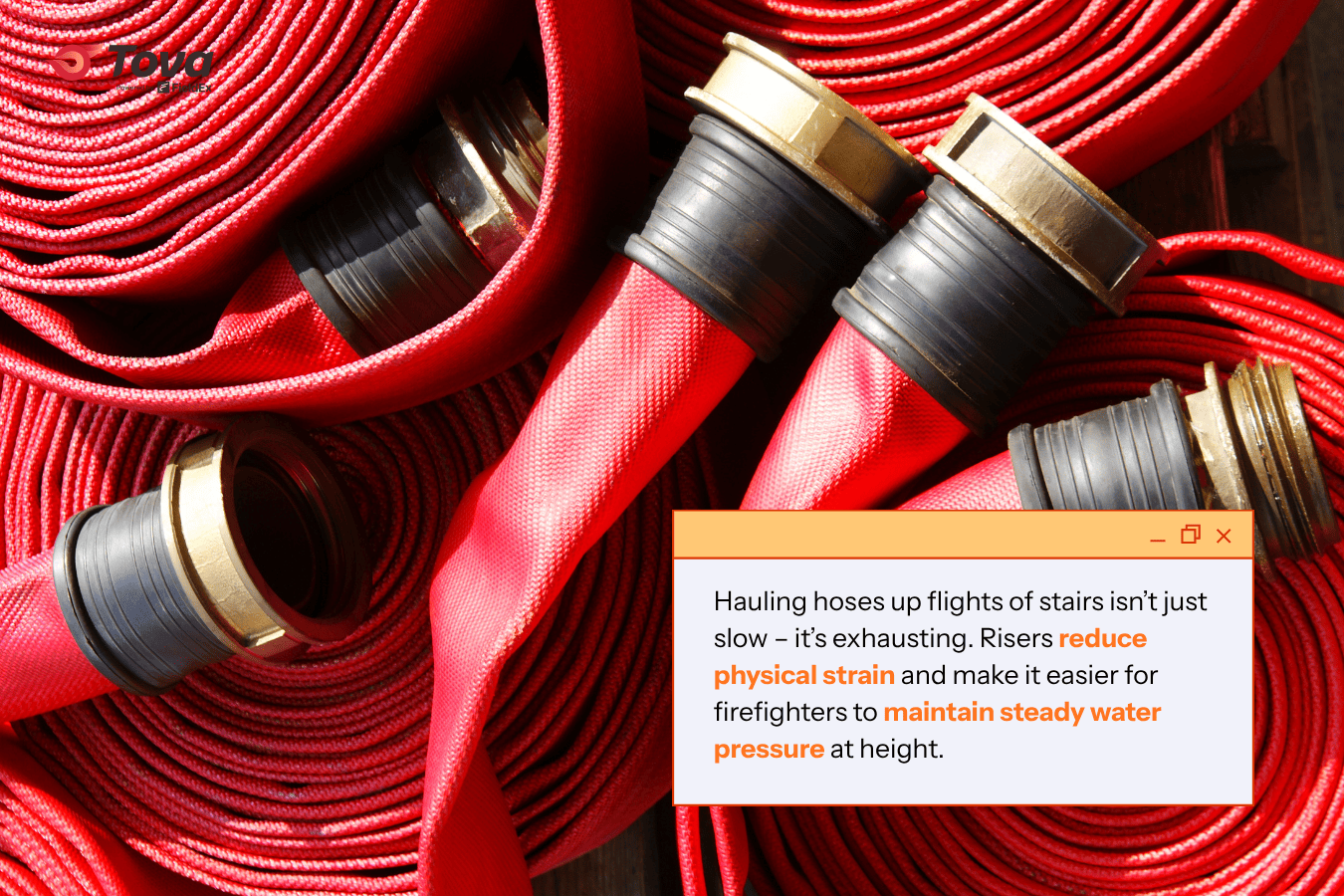
The faster a fire can be tackled, the more time occupants have to evacuate safely. By putting water exactly where it’s needed, risers help prevent fires from spreading uncontrollably. That means safer stairwells, clearer escape routes, and fewer lives at risk.
Hauling hoses up flights of stairs isn’t just slow – it’s exhausting. Risers reduce physical strain and make it easier for firefighters to maintain steady water pressure at height. That efficiency can make the difference between containing a fire and losing control of it.
Riser systems aren’t optional in tall buildings. They’re mandated by building codes like BS 9990 in the UK and NFPA 14 in the US. Non-compliance can mean hefty fines, denied insurance claims, or even building closures.
Fires that spread unchecked through upper floors often result in catastrophic losses. By enabling fast response and targeted water delivery, risers help keep damage confined to smaller areas, lowering repair costs and downtime.
The takeaway: Riser systems aren’t just about ticking a compliance box; they’re about buying precious minutes, protecting people, and giving firefighters the tools they need to do their jobs effectively.
Here’s the thing about risers: installing them is just the start. A riser that hasn’t been checked or tested is like a fire extinguisher with a dead gauge – it looks reassuring, but it won’t do much when disaster strikes. That’s why regular inspection and testing is non-negotiable.
Managing riser inspections manually can get messy, especially in large facilities with multiple systems. That’s where platforms like Tova help by:
Bottom line: A riser system is only as good as its last inspection. Staying on top of maintenance isn’t just about compliance; it’s about ensuring firefighters can rely on your system when it matters most.
Even the best-designed riser system can fail if it’s not looked after properly. Over the years, inspectors and firefighters have seen the same mistakes crop up again and again. Here are some of the big ones to avoid:
The ground-level inlet is the firefighter’s lifeline. If it’s blocked by rubbish, overgrown plants, or worse – painted over – it can’t be used quickly. Missing or broken caps can also let dirt, stones, or even soda cans clog the inlet.
Landing valves are often located in protected lobbies or stairwells. If fire doors in these areas are wedged open, smoke and flames can spread quickly, reducing the time firefighters have to use the riser effectively.
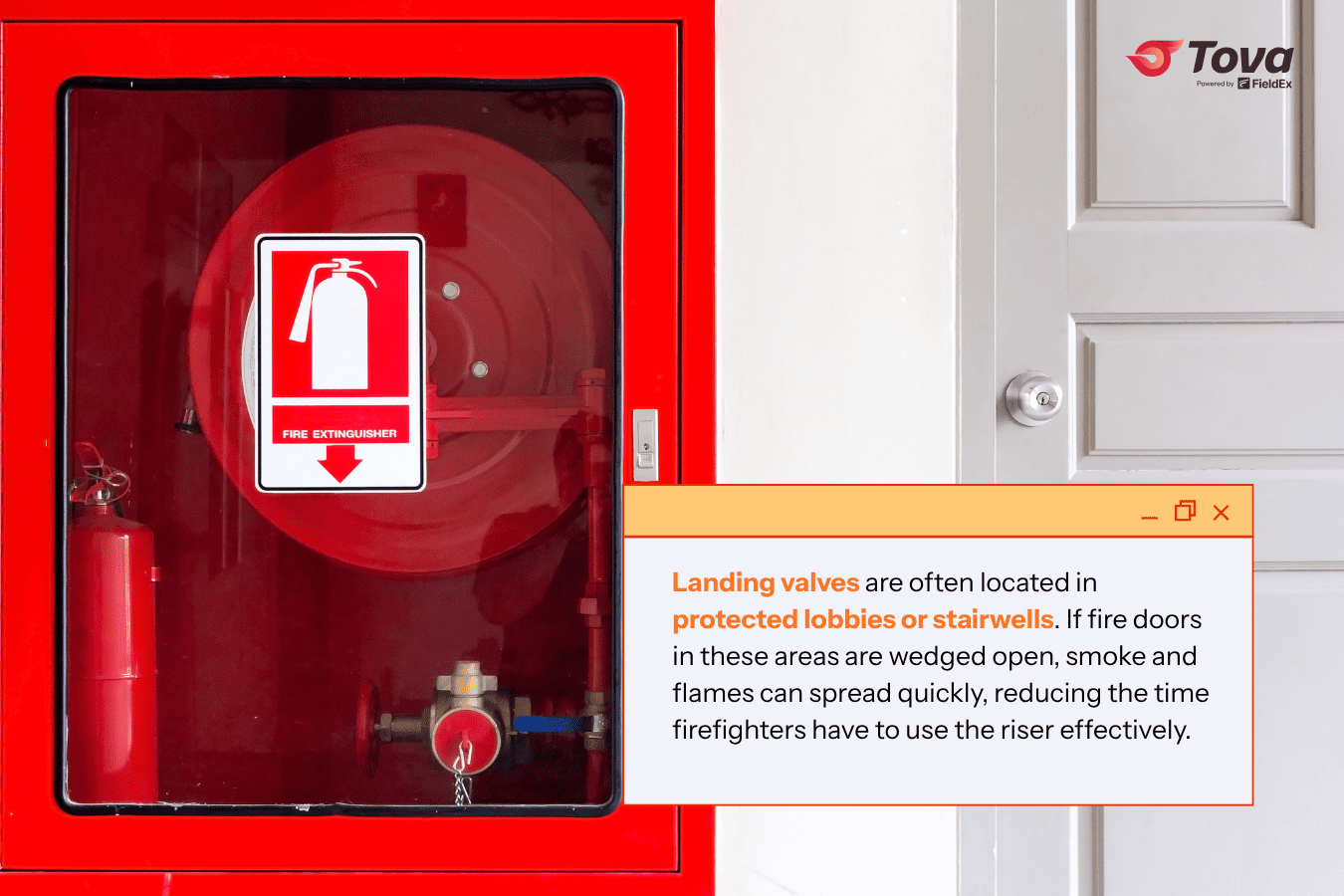
For wet risers, constant water pressure means joints, pipes, and valves can corrode or leak over time. Left unchecked, this leads to low pressure or complete system failure when it’s needed most.
Dry risers only come to life during an emergency – so unless they’re tested under pressure at least once a year, no one really knows if they’ll hold up. Skipping or delaying these tests is a recipe for unpleasant surprises.
Sometimes riser outlets are hidden behind furniture, shelving, or even newly built walls (yes, it happens). Clear signage and easy access are essential, otherwise firefighters waste precious minutes hunting for valves.
Inspections shouldn’t just be about filling in a form. If contractors or building managers rush through checks without properly testing components, faults get missed – and the system might fail when it’s needed most.
The bottom line: Riser systems are only reliable if they’re treated as critical safety infrastructure, not afterthoughts. Most failures aren’t caused by fancy technical issues – they’re the result of simple, preventable mistakes.
Riser systems may seem like simple pipes, but even this part of fire safety is evolving. New technology and stricter regulations are reshaping how wet and dry risers are designed, monitored, and maintained. Here’s what the future looks like:
Imagine a riser system that texts you when the pump loses pressure or when a valve gets stuck. With IoT-enabled sensors, that’s becoming reality. Continuous monitoring means faults can be spotted early – long before an emergency.
Risers won’t stay isolated. In modern smart buildings, they’re increasingly tied into BMS platforms, so facility managers can see pressure readings, tank levels, and inspection reminders alongside HVAC, lighting, and security systems.
Sustainability is creeping into every corner of construction. Expect to see energy-efficient pumps and low-maintenance tank systems that reduce the environmental footprint of wet risers while still meeting strict fire safety standards.
After high-profile fire disasters, regulators are tightening the rules. Codes like BS 9990 and NFPA 14 are being revised to demand more frequent inspections, tougher testing protocols, and better documentation. The result? Fewer loopholes and safer high-rises.
Paper logbooks are quickly becoming obsolete. Digital platforms like Tova already make it possible to schedule inspections, log results, and generate compliance reports in seconds. In the future, inspectors may expect this level of digital recordkeeping as standard practice.
The takeaway: Risers may always be “just pipes”, but the way they’re managed is changing fast – smarter, greener and more connected to the bigger safety picture.
Wet and dry risers may not grab attention like sprinklers or alarms, but in high-rise firefighting, they’re the unsung heroes. Whether it’s a wet riser permanently charged with water or a dry riser waiting to be filled by firefighters, both serve the same purpose: getting water where it’s needed, fast.
The type you’ll find in a building depends on height, design, and code requirements. Wet risers are the go-to for very tall structures where instant water is essential, while dry risers are perfectly suited for mid-rise buildings that don’t justify the cost and complexity of constant pressurization.
But remember: installation is only half the story. These systems need regular inspections, pressure tests and documentation to stay compliant – and more importantly, to stay reliable in a real emergency.
That’s where tools like Tova help. By automating inspection schedules, keeping digital records, and simplifying compliance, Tova makes it easier for safety teams to ensure riser systems are always ready for action.
Bottom line: Wet or dry, risers are lifelines. Look after them, and they’ll look after you.
A riser is a vertical pipe built into tall buildings that lets firefighters quickly deliver water to upper floors. Instead of dragging hoses up stairwells, crews connect to landing valves on each floor for faster response.
Both serve the same purpose but are used in different building types.
Wet risers are usually required in buildings taller than 50 meters (per UK BS 9990 standards). At that height, pumping water into a dry riser becomes unreliable, so a permanently charged system is necessary.
Dry risers are typically installed in buildings between 18 and 50 meters in height. They provide quick access points for firefighters without the complexity or cost of a wet riser system.
No. Risers and sprinklers serve different roles. Sprinklers automatically spray water when triggered by heat, while risers provide firefighters with a ready-made water supply to attack the fire directly.
The building owner or facility manager is responsible for keeping risers maintained, inspected, and compliant with codes. They may hire certified contractors to carry out tests and repairs.
Unmaintained risers can leak, lose pressure, or fail completely during a fire. Beyond the obvious safety risk, non-compliance can also lead to fines, denied insurance claims, or building shutdowns.
In theory, yes. But it usually requires major upgrades (water storage tanks, pumps and pressure controls). In most cases, it’s more practical to install the correct riser type during construction.
Platforms like Tova simplify riser maintenance by:
This makes staying compliant easier and ensures risers are always ready when firefighters need them.

.avif)